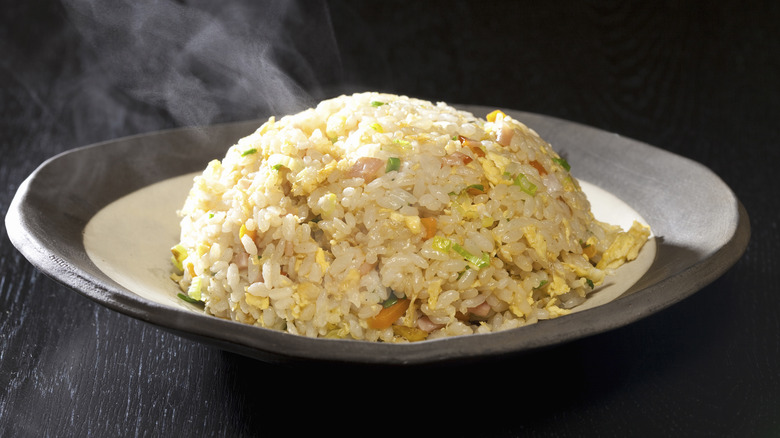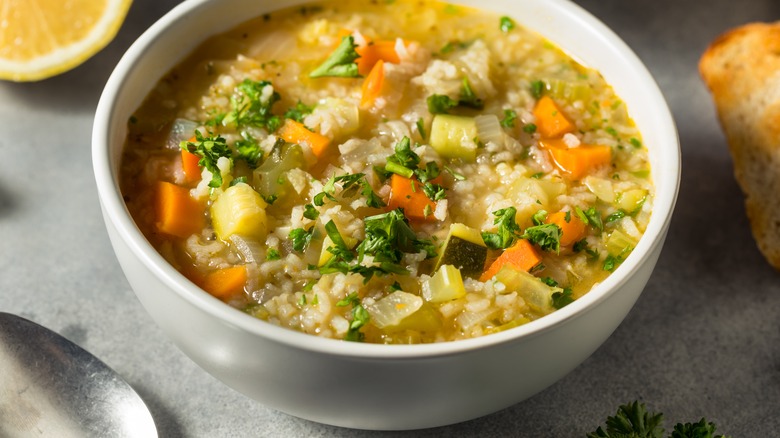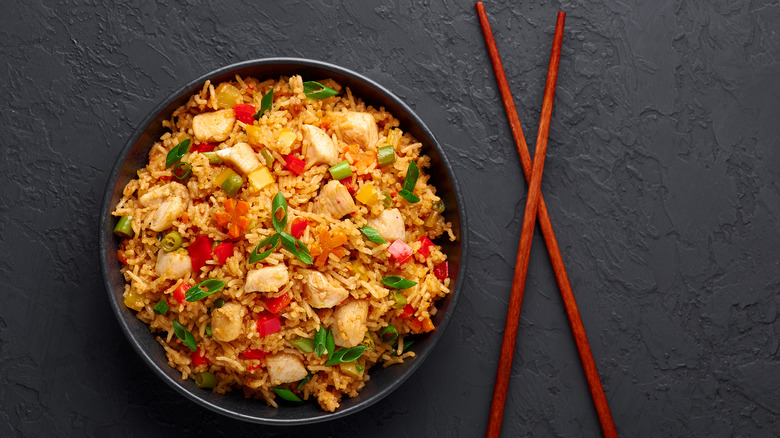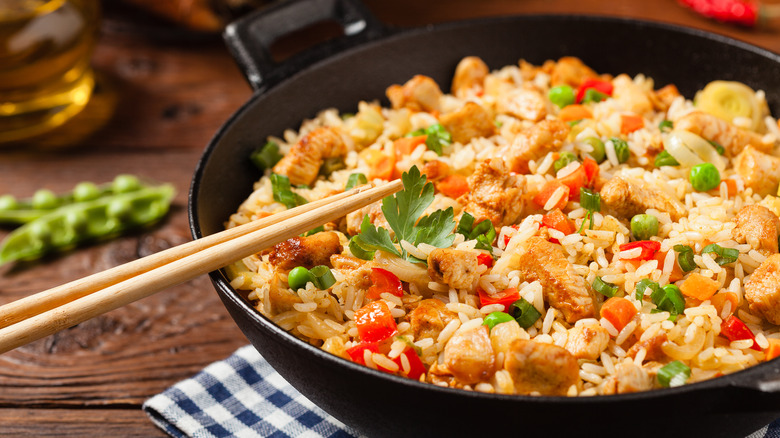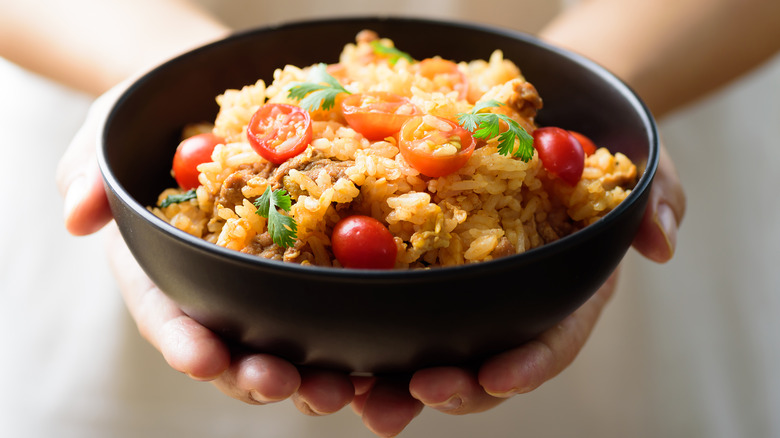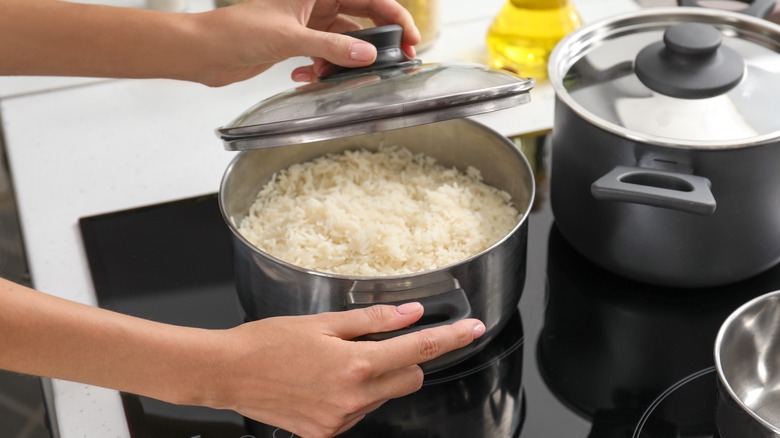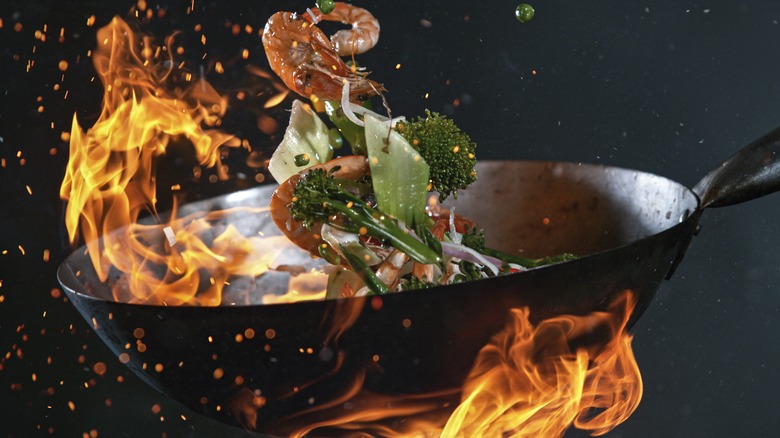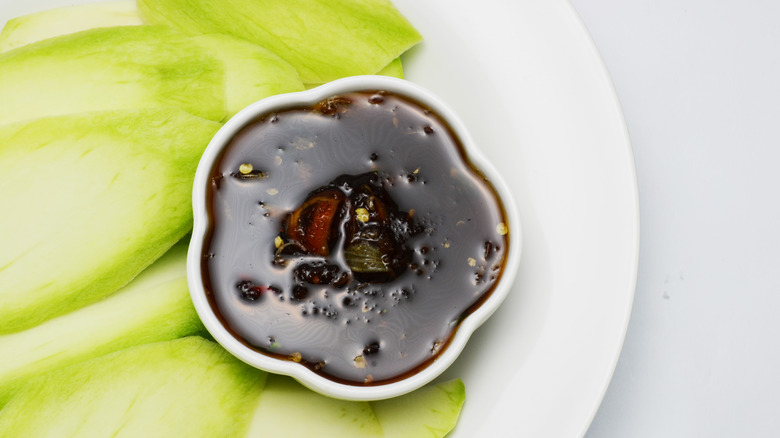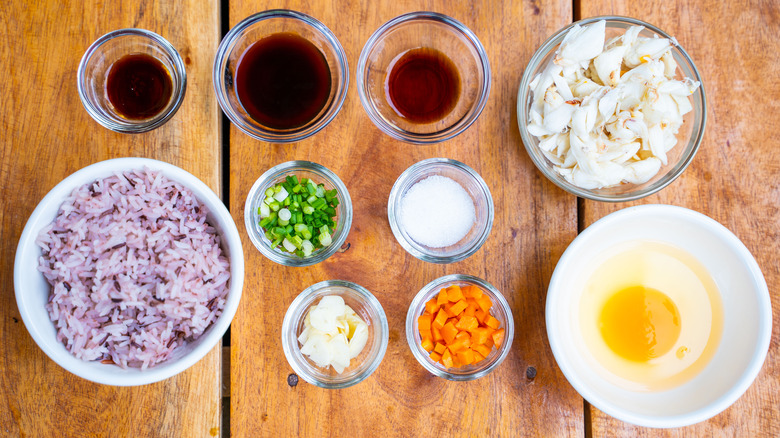You've Been Eating Fried Rice Wrong This Entire Time
Fried rice may be a staple menu item in Chinese restaurants, but that doesn't make it a typical Chinese food. On the contrary, this delicious combination of pan-fried rice, eggs, and vegetables is actually considered a stand-alone in Chinese cuisine (via Eating China). The reason for this is that many Chinese people prefer to eat steamed white rice as an accompaniment to the rest of their meals. As such, intentionally cooking rice along with several ingredients is not the region's most typical culinary method.
Nonetheless, fried rice was indeed invented in China sometime between 589 and 618 AD. The recipe was likely conceptualized as a way to use day-old rice in addition to other leftover ingredients that could include onions, shallots, and even bits of unused meat. While a bit uncommon in traditional cuisine, the result was ultimately so delicious that this treat exploded in popularity internationally. For example, fried rice became so commonplace in Japan that there even exists a Japanese version of the food. Over the years, it has also grown popular in the United States, Europe, and Canada.
In spite of fried rice's popularity, not everybody knows how to eat it correctly. From chopstick faux pas to ingredient struggles, there are plenty of common mistakes that fried rice fans make when attempting to eat this delightful creation.
You shouldn't mix your fried rice in soup
Fried rice is so delicious that it could be tempting to mix it with other ingredients. If you order a plate of fried rice along with a steamy bowl of soup, it might even seem like a good idea to dunk your rice in the broth. While this combination might sound intriguing, you should never actually mix your fried rice with soup. The reason for this pertains to Japanese rice-eating etiquette. According to RecipeTin Japan, adding rice to your soup — or even to your entree — is considered extremely rude in some Asian cultures. Consequently, if you dare to mix your rice with soup, you will risk offending someone else at the table.
While soup mixed with fried rice is off-limits, you can enjoy soup combined with veggies and noodles without breaking with Japanese etiquette. Ramen, for example, is a super popular dish in Japan, and you can eat it without making the people around you feel uncomfortable. After all, as reported by Japan Insider, this combination of noodles, broth, and meat is actually considered something of a "national dish." To make this comfort food at home, you can try using this quick and easy 15-minute ramen recipe. Just be sure to keep your rice away from your soup bowl.
Don't use your chopsticks to place fried rice in your friend's chopsticks
Food is best when shared with others, and many people delight in passing a bit of their dinner to a friend's plate. Because of this, if you are eating a perfectly-seasoned bowl of fried rice, you might feel compelled to share it with one of your dinner companions. You might even grab your chopsticks, pluck a few grains of rice out of your bowl, and place them in your tablemate's chopsticks. Unfortunately, however, this is a huge no-no.
According to China Education Tours and Link Japan Careers, the motion of passing anything between chopsticks can be distasteful for a lot of Asian cultures. The explanation pertains to the countries' distinct funeral practices. At Chinese and Japanese funerals, mourners often use chopsticks to pick up the bones of the person who passed, and then they pass the bones from one person's chopsticks to the next. As a result, if you try passing fried rice from your chopsticks to someone else's, your gesture will be considered wildly inappropriate.
Luckily, there are ways for you to connect with people abroad without running the risk of offending them. Instead of sharing your food with others, try to connect with people by displaying good table manners. Try improving your chopstick skills by reading up on the best way to hold them. Ultimately, respect is the best way to show people that you care.
You shouldn't stab your chopsticks vertically into your fried rice
Sharing fried rice between chopsticks is not the only rice-related taboo that stems from funeral cultures. Sticking your chopsticks upwards in a bowl of fried rice is also a major faux pas throughout much of Asia. According to China Education Tours, the image of the chopsticks pointing toward the sky recalls the shape of burning incense. Since incense is burned during Buddhist funerals as a sign of respect toward the deceased, it would be considered rude to replicate that image using your fried rice.
To avoid insulting your tablemates, never stab your chopsticks into your fried rice. Instead, set your chopsticks down horizontally on top of the chopsticks holder that will likely be sitting beside your bowl (via Mobal). Doing so is not only aesthetically pleasing; it is also more correct, according to many Asian cultures. In the case that there is no chopsticks holder available, fear not! You can always place your eating utensils horizontally on the top of your rice bowl. To be as respectful as possible, make sure to set your chopsticks so that they are parallel to each other. This way, you can enjoy your meal without making your eating companions feel uncomfortable.
You should hold the fried rice bowl close to your mouth
It's no secret that eating fried rice with chopsticks can be challenging. After all, chopsticks are a delicate type of utensil, and grains of rice are small. As a result, some folks may feel reluctant to use their chopsticks to eat a whole bowl of it. The good news, however, is that there are little tricks that can make the process easier. For example, rather than leaving your rice bowl on the table and forcing your chopsticks to make the long trip from the bowl to the mouth, you should try to decrease the distance between your food and its destination (via Kids Web Japan). People achieve this by picking up the rice bowl so that it's slightly closer to their mouths. Ultimately, this is a great strategy for preventing spillage. Whenever a piece of fried rice falls from the chopsticks, you can use your bowl to catch it.
While this all might sound great, be careful not to hold your bowl too close to your mouth. If it appears that you are literally shoveling fried rice into your mouth, it might look like you don't have any manners. As per Just Hungry, you should ideally hold your bowl far enough from your mouth that you can eat it without spilling but the bowl isn't touching your lips.
You shouldn't cook your fried rice with fresh rice
If you are craving a steamy bowl of fried rice, you may be tempted to whip up a fresh batch. If you don't have any leftover rice in the fridge, you might even head to the stove to cook a fresh pot. At the end of the day, aren't fresh ingredients always better than old ones? Unfortunately, in this case, the answer to that question is no. As discussed earlier, fried rice is a meal that was originally invented with the purpose of using day-old rice. Because of this, the ingredients and proportions were made with slightly stale leftovers in mind. And according to Food Is In The House, using fresh rice to make fried rice can result in a final product that's clumpy, mushy, or just plain wet.
To make good fried rice, make sure to use your leftovers. And, if you just made a huge pot of fresh rice, don't worry, There are plenty of other recipes that call for this delectable ingredient. For example, this delicious Spanish rice and beans recipe also mixes rice with various ingredients, such as beans, onions, oil, and garlic. However, unlike traditional fried rice, the Spanish rice and beans combo is ideally made with a base of same-day rice.
Using the right equipment matters
The phrase "fried rice" may call to mind other popular fried foods, like fried chicken, or fried onions. However, this meal is fundamentally different from those North American favorites. For one thing, fried rice isn't ever dunked in a boiling tub of oil. And for another, it shouldn't be cooked in just any old frying pan. The reason for this, according to Food Is In The House, is that fried rice needs to be prepared in a special type of skillet to help it achieve its signature crunchiness. It cannot be prepared in a narrow or shallow pan, as this cooking product could inadvertently steam the final product. Instead, when preparing fried rice, you should cook it in a large enough pan that the grains of rice fry evenly throughout.
In an ideal world, this would mean that all fried rice was cooked in a wok. However, most home cooks struggle to use this culinary tool, as it can take years to learn how to use it properly. According to CNN, Chinese chefs use this heavy frying pan over an extremely hot fire. Their intention is to cook everything thoroughly, yet quickly. To achieve this goal, these professionals must learn how to toss entire pans full of rice and noodles over the flames. As Hong Kong-based restaurant owner Danny Yip told CNN, "Why don't [more] chefs use a wok? It's heavy and the fire can be intimidating and hard to control."
Don't add a bunch of sodium to your meal
Sodium can taste good, but it isn't exactly good for you. And while it's important to make fried rice that tastes rich, you should also try to cook it with healthy ingredients. Unfortunately, artificial sauces, like soy sauce or sweet and sour sauce, have such a high salt content that you could easily consume your entire day's worth of sodium with just a few spoonfuls. In fact, according to Health, one tablespoon of soy sauce contains almost 900 milligrams of sodium. If we take into account the NHS's recommendations, that means that just three tablespoons of soy sauce hold more sodium than the average healthy person should eat in an entire day.
Because of this, you should try to avoid adding these unhealthy ingredients to your fried rice on a regular basis. Otherwise, you could end up with long-term health problems. WebMD warns that excess consumption of these sauces can lead to high blood pressure. Over time, this health issue can lead to issues, including heart disease and strokes. If you are looking to incorporate more low-sodium sauces into your cooking regime, try making lower-sodium yet flavorful choices like kimchi or miso. Your body might just thank you in the long run.
It's rude to eat fried rice with soy sauce
Health isn't the only reason to avoid mixing soy sauce with fried rice. In some cultures, this is also considered rude. Some chefs perceive the addition of soy sauce to their fried rice as a direct insult. In their eyes, a restaurant patron who dabs a bit of soy sauce over their food is signaling that there was something wrong with the meal. Because of this, it's best not to add soy sauce to your fried rice in some Asian restaurants. Otherwise, you might just offend the person who made your food.
In some countries, like Japan, mixing rice with sauce is also considered bad manners (via RecipeTin Japan). And, interestingly, this rule is so strict that it applies to rice in any form. Even sushi rice shouldn't be dunked into a tray of soy sauce (via Eat-Japan). To avoid being rude and over-salting your meal, you should be sure to dip your sushi into the soy sauce in such a way that only the fish comes into contact with the salty condiment. The rice in your sushi roll should ideally stay clean.
